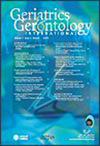Are circadian rest–activity rhythms sex-specific markers of frailty risk in older adults? A narrative review
Abstract
Aim
Physical frailty, a common geriatric syndrome driven by an age-related decline in physiological systems, is associated with an increased risk of further chronic diseases and mortality, making it a significant public health concern. Disrupted circadian rest–activity rhythms (RARs) are increasingly recognized as clinical indicators of physical frailty in older adults; however, limited research hinders a robust understanding of these associations, and potential sex differences remain largely underexplored.
Methods
This narrative review summarizes the age-related changes in RARs, their association with physical frailty, and possible underlying physiological mechanisms. Additionally, the role of sex in their associations is discussed.
Results
Although evidence is limited, consistent findings have shown significant associations between circadian RARs and physical frailty, suggesting that RARs could be a risk factor and a practical, measurable marker of frailty. The lack of standardized measures for both RARs and frailty continues to challenge the robustness of their relationship. Given the distinct RAR patterns and frailty components explained by sex-specific physiological and socio-behavioral factors, biological sex possibly plays a significant role in the links between RARs and frailty.
Conclusions
The identified knowledge gap hinders a comprehensive understanding of the complex associations between RARs and frailty beyond pathophysiology, limiting the development of practical implications and effective intervention strategies for addressing frailty in older adults. Further longitudinal and experimental studies are required to elucidate sex-specific, personalized public health approaches accounting for social factors, leveraging RARs as a critical indicator for the effective management of frailty. Geriatr Gerontol Int 2025; 25: 1035–1046.


 求助内容:
求助内容: 应助结果提醒方式:
应助结果提醒方式:


